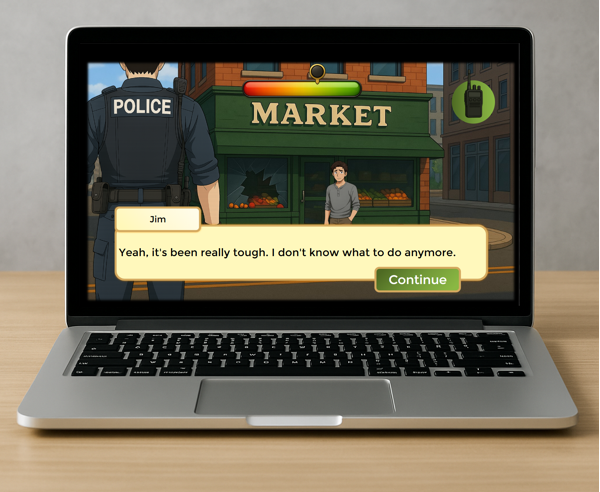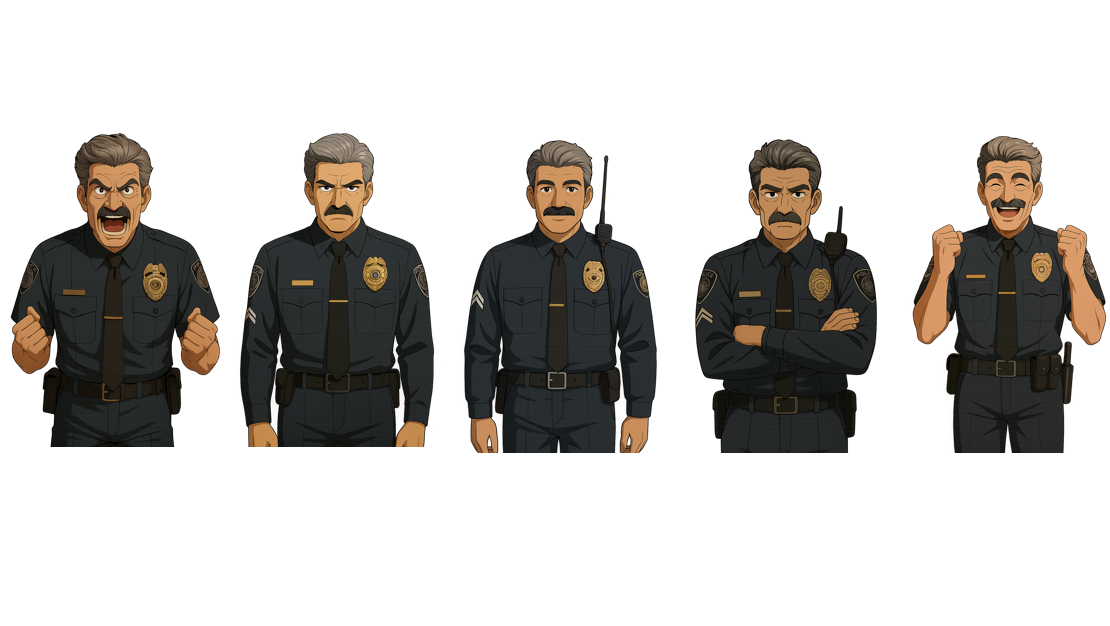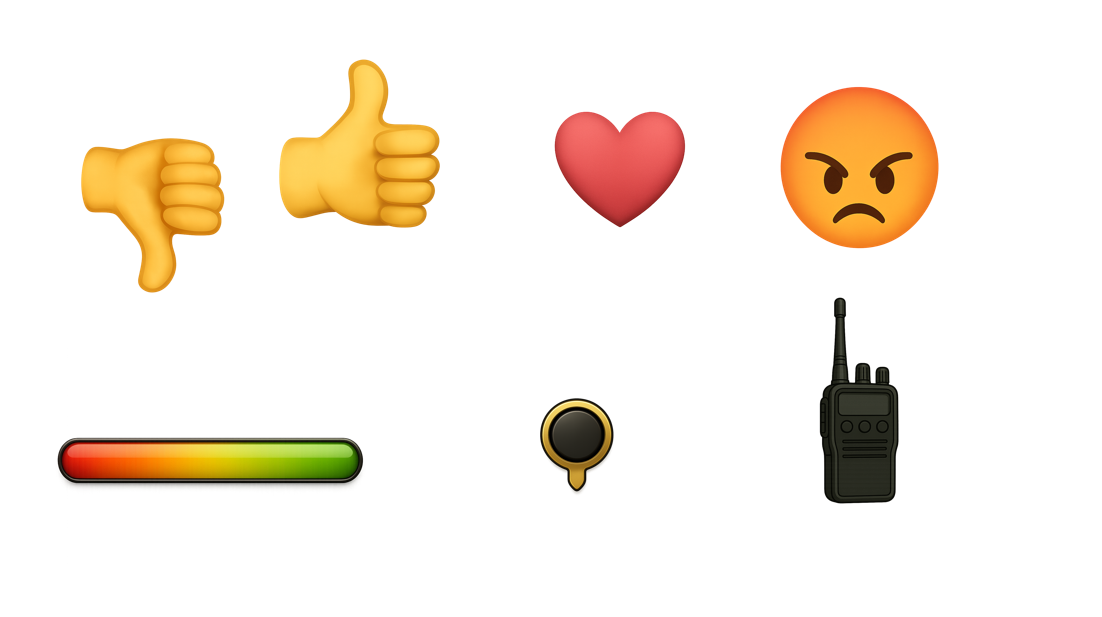Crisis Negotiation: Every Second Counts. Every Word Matters
This scenario-based eLearning project explores how empathy and communication can reshape high-stakes policing encounters. By merging immersive storytelling with AI-driven interactions, the project empowers officers to practice de-escalation strategies that influence real-world behaviour. Designed to last, inspire, and change, this simulation gives officers the tools—and the space—to reflect, adapt, and lead with humanity.
Audience: Police Officers (Crisis Negotiation, Tactical, and Patrol Units)
Responsibilities: Instructional Design, Scenario Writing, AI Chatbot Programming, Visual Development, JavaScript Integration, Storyboarding
Tools Used: Articulate Storyline 360, JavaScript, Custom API, ChatGPT, Claude AI, Microsoft Suite, Google Suite
The Problem
In high-pressure situations, many officers rely on instinct or force rather than empathy. Common performance gaps include:
Difficulty recognizing and responding to emotional distress.
Ineffective communication that escalates instead of diffuses.
Missed non-verbal cues and inability to adapt in real-time.
Limited practice applying empathy in unpredictable, live scenarios.
These issues can lead to excessive force, harm to civilians and officers, legal liabilities, and damaged public trust—especially when such moments are captured on camera or posted to social media.
The Solution
The goal: increase successful de-escalations by 30% over six months.
Key actions identified:
Use empathetic verbal strategies (mirroring, labeling, calibrated questions).
Maintain a calm tone and controlled body language.
Adapt responses based on evolving emotional cues.
Designed to Last – Officers engage in branching scenarios that reinforce empathy through repeated practice and consequence-driven outcomes.
Designed to Inspire – Learners feel the weight of their decisions through facial expressions, tone shifts, and public reaction.
Designed to Change – The project bridges the gap between theoretical training and real-world pressures by simulating time-sensitive, emotionally charged encounters.
I created a dynamic, AI-powered simulation that immerses officers in a realistic crisis negotiation with a distressed civilian. The experience is:
Action Map
This Project was featured on the Devlin Peck Channel
I had the honour of having my project showcased alongside other incredible AI creations from talented Instructional Designers in the field. Watch to see how we’re using Chatbots to bring interactivity and engagement to learning experiences.
Storyboard
I developed a scene-by-scene narrative featuring Jim, a distressed man outside a grocery store. His emotional state is reactive and shifts with the learner’s choices, guided by a visible tension meter mechanic.
Consequences are layered:
Immediate feedback via body language and tone.
Narrative consequences like Jim resisting arrest or surrendering.
Social consequences, such as a bystander taking a photo during the arrest, showing how officer behaviour is publicly scrutinized.
Professional consequences, including a debrief from the sergeant and mentor AI feedback.
Visual & AI Design
Unable to find suitable assets, I generated custom visuals using AI tools. Each version of Jim—anxious, aggressive, relieved—was illustrated with intent, reflecting the learner’s impact. Backgrounds, such as the police cruiser, grocery store, and precinct office, were also AI-generated to maintain cohesion.
The colour palette was chosen to balance seriousness with clarity. The tension meter and UI elements were designed for quick emotional readability, reinforcing urgency without distraction.
Inspiration from Law of the West
The visual framing and interactive dialogue of this project were inspired by Law of the West, a Commodore 64 game I played as a child. The game allowed players to choose dialogue options as a sheriff in the Old West, shaping outcomes based on tone and timing. That early experience planted the seed for my interest in dialogue-driven storytelling. In this project, I reimagined that setting in a modern law enforcement context, positioning the learner as the officer and Jim as the emotionally volatile character they must engage with—honouring the spirit of that early inspiration while elevating it through today’s learning technologies.
The Power of Consequences and Community Perception
Consequences are central to the experience. Learners don’t just see if they succeeded or failed—they feel it. Jim’s facial expressions and body language shift dynamically in response to their choices. More importantly, I layered in social consequences through simulated social media reactions. A single moment of escalation may result in viral backlash or public scrutiny, while a de-escalation success earns positive community sentiment. This reinforces the real-world stakes that officers face—where every interaction is potentially recorded, shared, and judged.
By visualizing both emotional and societal consequences, the scenario challenges learners not only to resolve the situation but to reflect on their role in shaping public trust.
AI, Chatbot & JavaScript Integration
I trained myself in JavaScript and API integration, using ChatGPT and Claude AI as my mentors. The AI chatbot allows learners to type responses freely, with dynamic feedback triggered by backend logic.
Jim's programming includes escalating or calming states, depending on tone, empathy, and timing.
Luana, the AI mentor, offers in-the-moment feedback through a radio icon and provides summative coaching at the end, reinforcing specific actions that helped—or hindered—resolution.
Results and Takeaways
While this simulation was developed as a flagship portfolio piece, it reflects a real-world solution I believe could transform crisis negotiation training in law enforcement.
Financial Value:
Reduces the risk of lawsuits, injuries, and reputational damage by preparing officers for high-stakes conversations without costly in-person training.
Strategic Value:
Promotes de-escalation culture in policing through immersive, repeatable practice that scales across departments.
Personal Value:
Empowers officers to see—and feel—the results of their approach. By confronting their impact in a safe environment, they build confidence and communication skills that can save lives.
This project represents more than just a simulation—it’s a message: empathy isn’t a soft skill; it’s a survival skill. One that every officer deserves to practice.


























